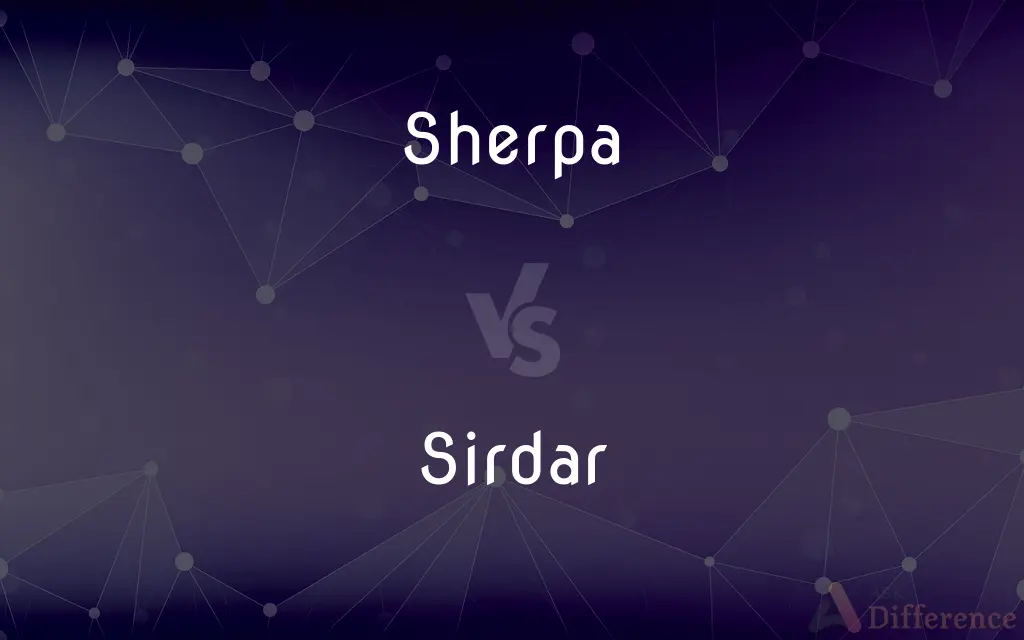Sherpa vs. Sirdar — What's the Difference?
By Tayyaba Rehman & Maham Liaqat — Updated on April 26, 2024
Sherpas are an ethnic group known for mountaineering skills in the Himalayas, while Sirdars typically refer to leaders or officials in various capacities.

Difference Between Sherpa and Sirdar
Table of Contents
ADVERTISEMENT
Key Differences
Sherpas are an ethnic group from the Himalayan region, renowned for their expertise in mountaineering and guiding. Whereas, Sirdars have historically been used to describe foremen or leaders, particularly in South Asia, but the term can apply to various leadership roles.
In mountaineering contexts, Sherpas are essential for their knowledge of the terrain and their physical acclimatization to high altitudes. On the other hand, a Sirdar might be responsible for managing a team of Sherpas, organizing logistics, or leading expeditions.
The Sherpa community plays a crucial role in supporting expeditions to peaks like Everest by carrying supplies and setting up camps. In contrast, a Sirdar, in this context, may not necessarily be from the Sherpa community but holds a position of authority and coordination.
Sherpas also embody a rich cultural heritage with deep roots in Tibetan Buddhism, which influences their way of life and traditions. Meanwhile, the term Sirdar can refer to individuals of various cultural and religious backgrounds, depending on their geographic and professional context.
While Sherpas are specifically associated with the geographic region of Nepal and its mountaineering industry, Sirdars can be found in various fields such as military, agriculture, or even within educational contexts, reflecting a broader application of the term.
ADVERTISEMENT
Comparison Chart
Origin
Ethnic group from Nepal
Leadership title, varies by region
Primary Context
Mountaineering, trekking guides
Leaders, foremen in various capacities
Cultural Association
Strong ties to Tibetan Buddhism, Nepali culture
Varies, but often linked to South Asian contexts
Professional Role
Guide, porter in Himalayan expeditions
Managerial or leadership roles in diverse fields
Geographical Link
Specifically linked to the Himalayas and Nepal
Broader application, not specific to one region
Compare with Definitions
Sherpa
A porter or guide employed in mountain expeditions.
The team relied on the Sherpa for knowledge of the local terrain.
Sirdar
Can imply a person of authority and respect in general usage.
He was regarded as the Sirdar by his peers due to his leadership qualities.
Sherpa
Someone of Sherpa descent, often involved in the mountaineering industry.
He hired a Sherpa for his extensive experience on Everest.
Sirdar
A managerial position in various professional fields.
As a Sirdar, his responsibilities included overseeing the entire operation.
Sherpa
A general term for Himalayan mountaineering support staff, regardless of ethnicity.
All the Sherpas at base camp were ready for the ascent.
Sirdar
A title used historically for a leader or chief in South Asia.
The Sirdar of the village called a meeting.
Sherpa
Symbolically, anyone who supports an expedition or a project.
She was the Sherpa, leading her team through the project's challenges.
Sirdar
A foreman or supervisor, particularly in a military or labor context.
The Sirdar managed the workers on the site.
Sherpa
A member of an ethnic group from the Himalayas, known for mountain climbing.
The Sherpa guided the climbers through the dangerous icefall.
Sirdar
Used in mountaineering to denote the head of guides or porters.
The Sirdar coordinated all logistical aspects of the expedition.
Sherpa
A member of a Himalayan people living on the borders of Nepal and Tibet, renowned for their skill in mountaineering.
Sirdar
The rank of Sirdar – a variant of Sardar – was assigned to the British Commander-in-Chief of the British-controlled Egyptian Army in the late 19th and early 20th centuries. The Sirdar resided at the Sirdaria, a three-block-long property in Zamalek which was also the home of British military intelligence in Egypt.
Sherpa
A member of a traditionally Buddhist people of Tibetan ancestry living on the southern side of the Himalaya Mountains in Nepal and the Indian state of Sikkim. In modern times Sherpas have achieved renown as high-altitude porters and expert guides on Himalayan mountaineering expeditions.
Sirdar
A person of high rank, especially in India.
Sherpa
(countable) A local mountain guide or porter, particularly a male of the Nepalese Sherpa people so employed.
Sirdar
The rank held in the Egyptian army by the British commander-in-chief in Egypt between 1883 and 1899 during the period of British occupation of Egypt.
Sherpa
(countable) An expert accompanying a high-ranking leader to a summit meeting.
Sirdar
A high-ranking person in India and other areas of west-central Asia; a chief, a headman.
Sherpa
A synthetic fabric with a long, thick pile, similar to faux fur, imitation lamb wool, or fleece.
Sirdar
A rank assigned to the commander-in-chief of the Egyptian Army during the British occupation of Egypt.
Sherpa
(rare) To serve as a guide or porter for another.
Sirdar
The leader of a group of Sherpa mountain guides.
Sherpa
A member of the Himalayan people living in Nepal and Tibet who are famous for their skill as mountaineers
Sirdar
A native chief in Hindostan; a headman.
Sirdar
In Turkey, Egypt, etc., a commander in chief, esp. the one commanding the Anglo-Egyptian army.
Sirdar
An important person in India
Common Curiosities
What is a Sherpa?
A Sherpa is a member of an ethnic group from the Himalayas, renowned for their expertise in mountaineering.
How are Sherpas culturally significant?
Sherpas have a rich cultural heritage deeply influenced by Tibetan Buddhism, which permeates their customs, traditions, and lifestyle.
Who can be called a Sirdar?
A Sirdar can be anyone in a position of leadership or authority, often in a supervisory or managerial capacity.
What roles do Sherpas play in mountaineering?
Sherpas serve as guides, porters, and support staff in mountain expeditions, crucial for their success.
How do Sherpas acclimatize to high altitudes?
Sherpas have genetic adaptations that allow them to live and work effectively at high altitudes, which includes unique hemoglobin-binding capacities and vascular functions.
Are there different ranks or types of Sirdars?
In various contexts, there can be different ranks or types of Sirdars, especially in structured organizations like the military or large plantation operations, where titles such as Senior Sirdar or Chief Sirdar might be used.
Can anyone become a Sirdar in mountaineering?
While technically anyone with the requisite leadership skills and experience can become a Sirdar in mountaineering, it typically requires extensive knowledge of the terrain, logistics management, and prior experience in leading expeditions.
Is Sirdar a title specific to a particular profession?
No, Sirdar is a versatile title used across various fields, including military, agriculture, and mountaineering.
What training do Sherpas undergo for mountaineering?
Sherpas often start learning about mountaineering from a young age, gaining experience through local climbs and formal training programs, which may include first aid, rescue operations, and advanced climbing techniques.
What impact have Sherpas had on Himalayan expeditions historically?
Historically, Sherpas have been indispensable to the success of Himalayan expeditions, providing expert guidance, local knowledge, and physical support, and have been instrumental in numerous historic ascents, including those of Mount Everest.
Share Your Discovery

Previous Comparison
Junky vs. Junkie
Next Comparison
Collaboration vs. ConfrontationAuthor Spotlight
Written by
Tayyaba RehmanTayyaba Rehman is a distinguished writer, currently serving as a primary contributor to askdifference.com. As a researcher in semantics and etymology, Tayyaba's passion for the complexity of languages and their distinctions has found a perfect home on the platform. Tayyaba delves into the intricacies of language, distinguishing between commonly confused words and phrases, thereby providing clarity for readers worldwide.
Co-written by
Maham Liaqat















































